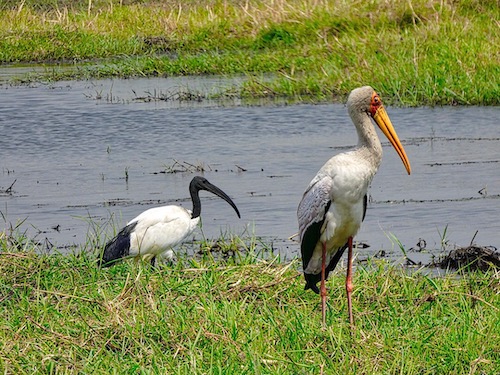
In a previous post, I presented examples of the smaller birds I saw on my recent trip to Botswana, in this post I thought I would show the larger birds. I saw the two beautiful birds seen above in Chobe National Park in Botswana, about an hours drive from Victoria Falls. Chobe is well renowned as a superb bird sanctuary featuring many different waterfowl, raptors, woodland species and migrants. In addition the Okavango Delta supports large concentrations of animals on both a permanent and seasonal basis. It has become perhaps one of the best places to see animals and birds in Africa. In between, there are many large and small birds adapted to the semi-arid bush during the winter. I have arbitrarily put Hornbills, Heron and Storks in separate posts to make the post more manageable. There a total 593 species of birds in Botswana, of which 4 have been introduced by humans, and 100 are rare or accidental. Of course, I did not see all of them but these posts cover the ones I did see.
African Darter
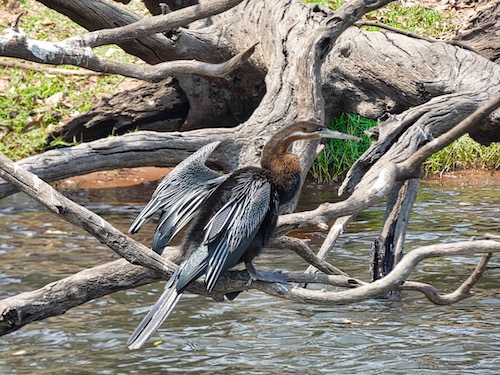
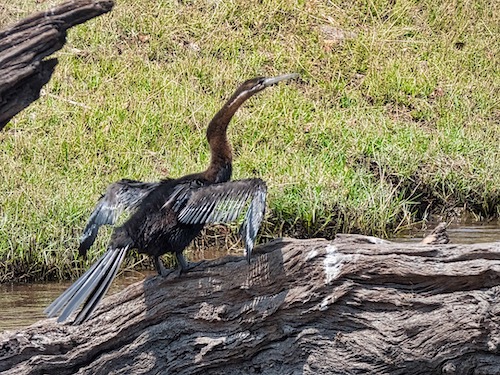
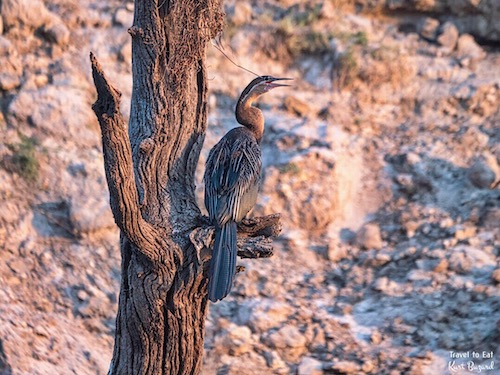
The African darter (Anhinga rufa), sometimes called the snakebird, is a water bird of sub-Saharan Africa and Iraq, about 2.5-3 ft (80-90 cm) long, weighing 2.2-3.7 lb (1-1.7 kg) with a wingspan of 4-4.3 ft (1.2–1.3 m). The African darter is a member of the darter family, Anhingidae, and is closely related to American (Anhinga anhinga), Oriental (Anhinga melanogaster), and Australasian (Anhinga novaehollandiae) darters. It often swims with only the neck above water, hence the common name snakebird. This is a habit shared with the other anhingas. Unlike many other waterbirds the feathers of the African darter do not contain any oil and are therefore not waterproof. Because of this, the bird is less positively buoyant and its diving capabilities are enhanced. After diving for fish, the feathers can become waterlogged. In order to be able to fly and maintain heat insulation, it needs to dry its feathers. Thus the African darter is often seen sitting along the waterside spreading its wings and drying its feathers in the wind and the sun as seen above. The male is mainly glossy black with white streaking and a white stripe down the side of the neck, but females and immature birds are browner.
African Jacana
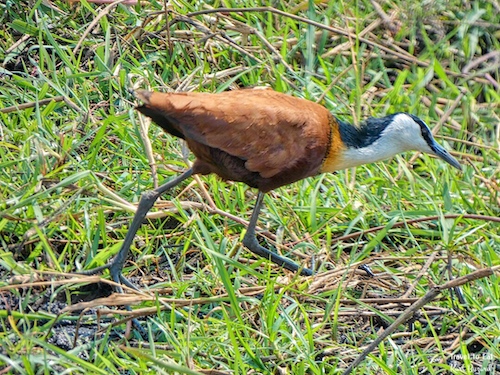
The African Jacana (Actophilornis africanus) is a wader in the family Jacanidae, identifiable by long toes and long claws that enable them to walk on floating vegetation in shallow lakes, their preferred habitat. Jacanas are found worldwide within the tropical zone, and this species is found in sub-saharan Africa. They are about 12 in (30 cm) long, but females are larger than males. They have chestnut upperparts with black wingtips, rear neck, and a black eyestripe. The underparts are also chestnut in the adults, in juveniles they are white with a chestnut belly patch. The blue bill extends up as a coot-like head shield, and the legs and long toes are grey. African Jacanas feed on insects and other invertebrates picked from the floating vegetation or the surface of the water.
Reed Comorant
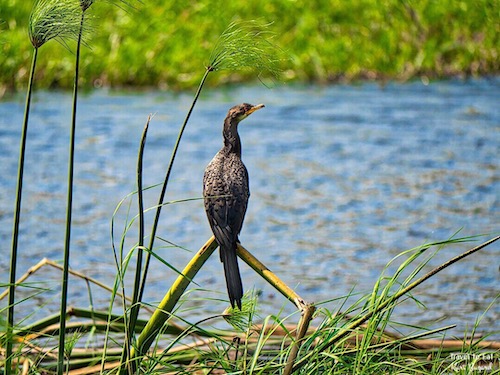
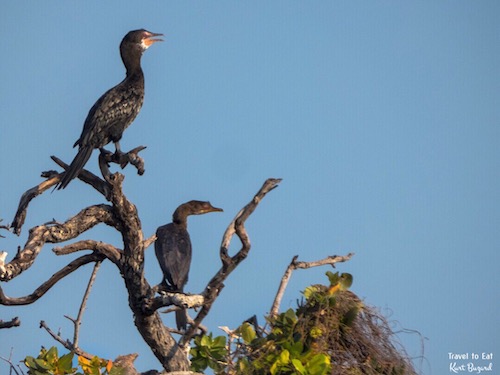
The Reed Cormorant (Microcarbo africanus), also known as the long-tailed cormorant, is a bird in the cormorant family Phalacrocoracidae, about 1.8 ft (50–56 cm) long. It breeds in much of Africa south of the Sahara, and Madagascar. It is resident but undertakes some seasonal movements. The reed cormorant can dive to considerable depths, but usually feeds in shallow water. It frequently brings prey to the surface. It takes a wide variety of fish. It prefers small slow-moving fish, and those with long and tapering shapes, such as mormyrids, catfishes, and cichlids.
Water Thick-Knee
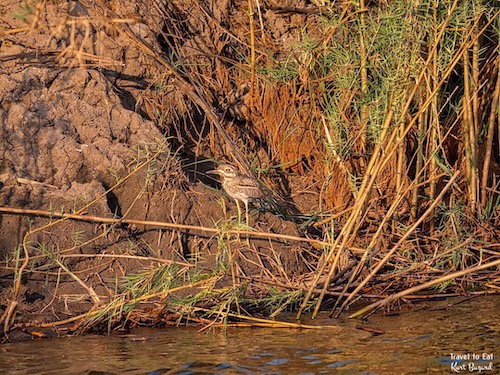
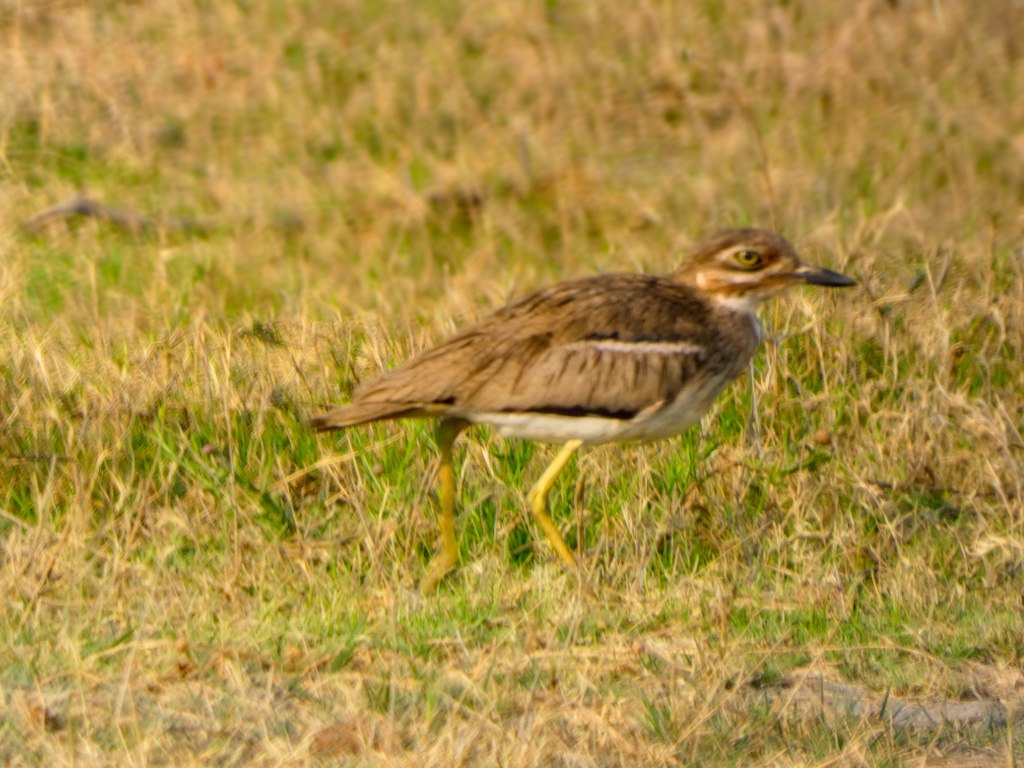
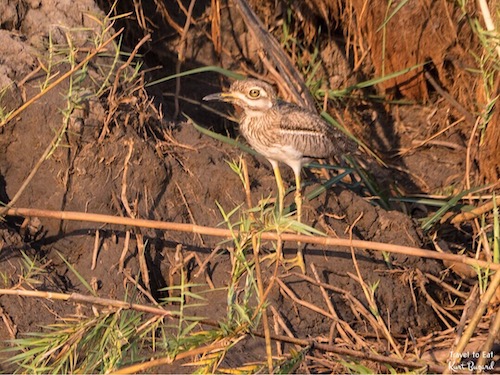
The Water Thick-Knee (Burhinus vermiculatus), or water dikkop is a species of bird in the family Burhinidae, about 1.2–1.3 ft (38–41 cm) long. This bird has a specially adapted bill which helps it hunt for fish, crabs, shrimp and other aquatic animals in the water. It also eats insects such as butterflies, bees, wasps, locusts, termites and ants. The Water Thick-knee is found in the Southern African wetlands, riverine forests and moist grasslands. They are usually solitary birds, found in pairs when breeding but may also be found in small flocks when not breeding. They are mainly nocturnal but may be quite vocal in full daylight, calling with a mournful “ti-ti-ti”. Although they can fly strongly, they seem to prefer to run than to fly when disturbed. The Water Thick-knee is a monogamous bird which means that the bird finds and breeds with one partner for the rest of its life. The bird builds its nest on the ground with figs, straw and leaves. The nest is placed under a bush to protect the young from predators.
Common Greenshank
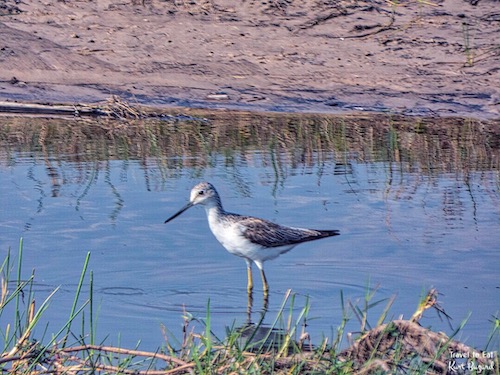
The Common Greenshank (Tringa nebularia) is a wader in the large family Scolopacidae, the typical waders. The genus name Tringa is the New Latin name given to the green sandpiper by Aldrovandus in 1599 based on Ancient Greek trungas, a thrush-sized, white-rumped, tail-bobbing wading bird mentioned by Aristotle. It is 12–14 in (30–34 cm) long with a wingspan of about 2 ft (68 cm). Its closest relative is the greater yellowlegs, which together with the spotted redshank form a close-knit group. Among them, these three species show all the basic leg and foot colors found in the shanks. This is a subarctic bird, breeding from northern Scotland eastwards across northern Europe and Asia. It is a migratory species, wintering in Africa, the Indian subcontinent, and Australasia, usually on fresh water. Greenshanks eat insects, worms, molluscs, small fish and crustaceans, feeding both by day and night. They feed by picking from the surface, probing, sweeping and lunging at the edges of mudflats or shallows. They may walk along the shoreline and even chase small fish in the shallow water.
Common Sandpiper
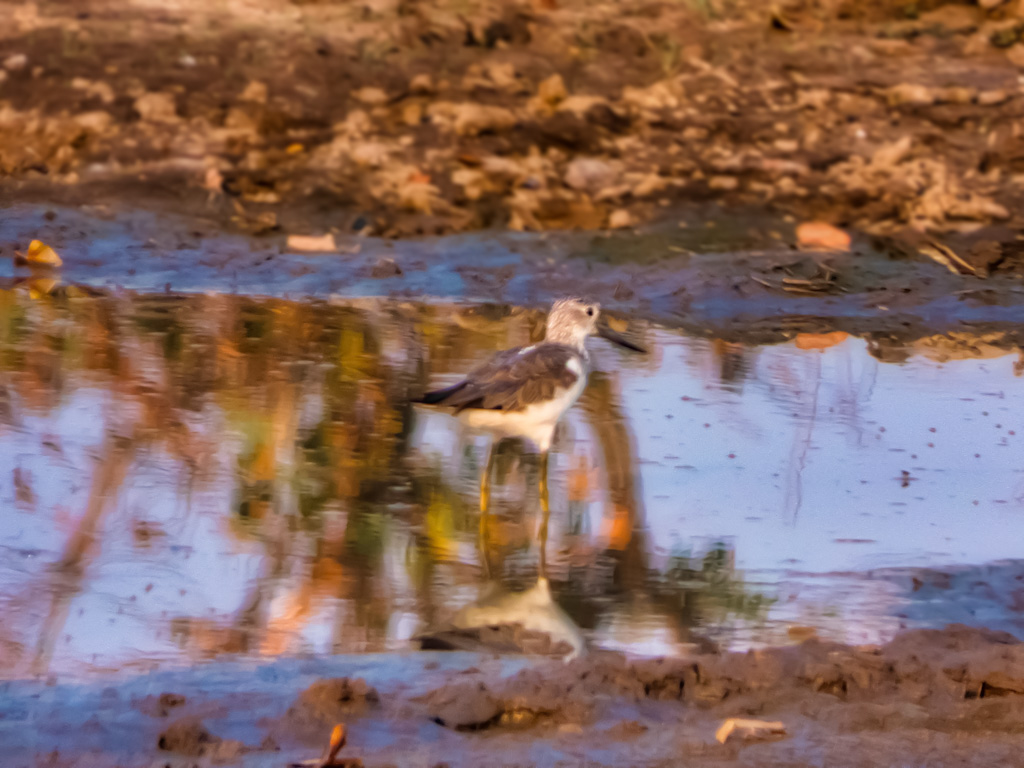
The breeding range of the Common Sandpiper (Actitis hypoleucos) extends from Europe, east across central Asia, to Kamchatka and Sakhalin, Russia, and Japan. A migratory species, its winter range extends from Western Europe and Africa, through the Middle East and South Asia, to Indonesia and Australia. The adult is 7.1–7.9 in (18–20 cm) long with a 13–14 in (32–35 cm) wingspan. It has greyish-brown upperparts, white underparts, short dark-yellowish legs and feet, and a bill with a pale base and dark tip. A diagnostic feature is an obvious white shoulder in front of the closed wing. The common sandpiper forages by sight on the ground or in shallow water, picking up small food items such as insects, crustaceans and other invertebrates; it may even catch insects in flight.
Blacksmith Plover
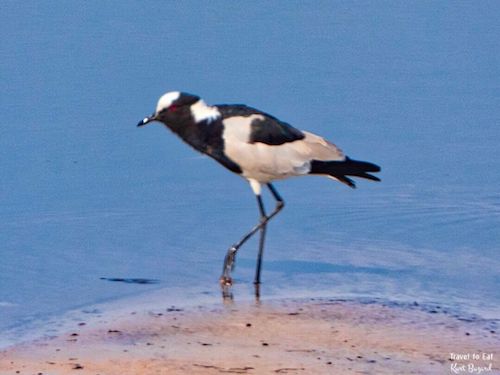
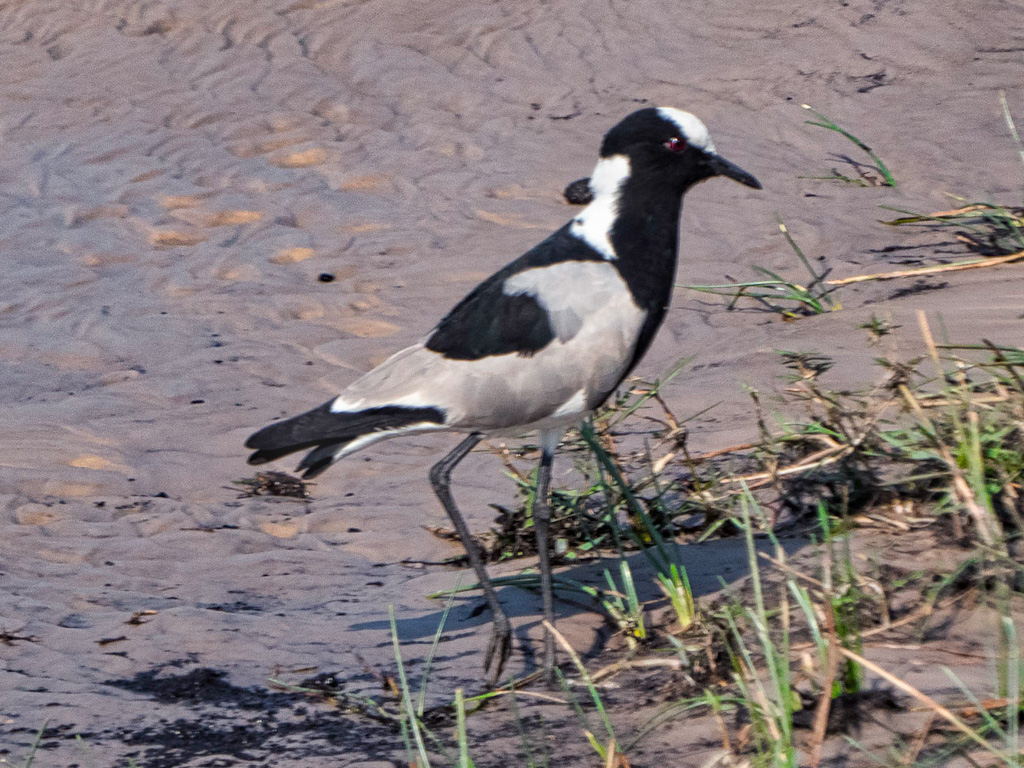
The Blacksmith Lapwing or Blacksmith Plover (Vanellus armatus) occurs commonly from Kenya through central Tanzania to southern and southwestern Africa. The vernacular name derives from the repeated metallic ‘tink, tink, tink’ alarm call, which suggests a blacksmith’s hammer striking an anvil. It is about 11-12 in (28–31) cm long, weighing 4.6-7 oz (130–200 g), with a wingspan of 2.6 ft (78 cm). Blacksmith lapwings are very boldly patterned in black, grey and white, possibly warning colors to predators. The blacksmith plover occurs in association with wetlands of all sizes. Even very small damp areas caused by a spilling water trough can attract them. It avoids mountains of any type. Blacksmith plovers eat invertebrates, including insects, crustaceans and mollusks. These birds have been observed “fishing” by holding a trembling foot in shallow water to lure prey to the surface.
African Fish Eagle
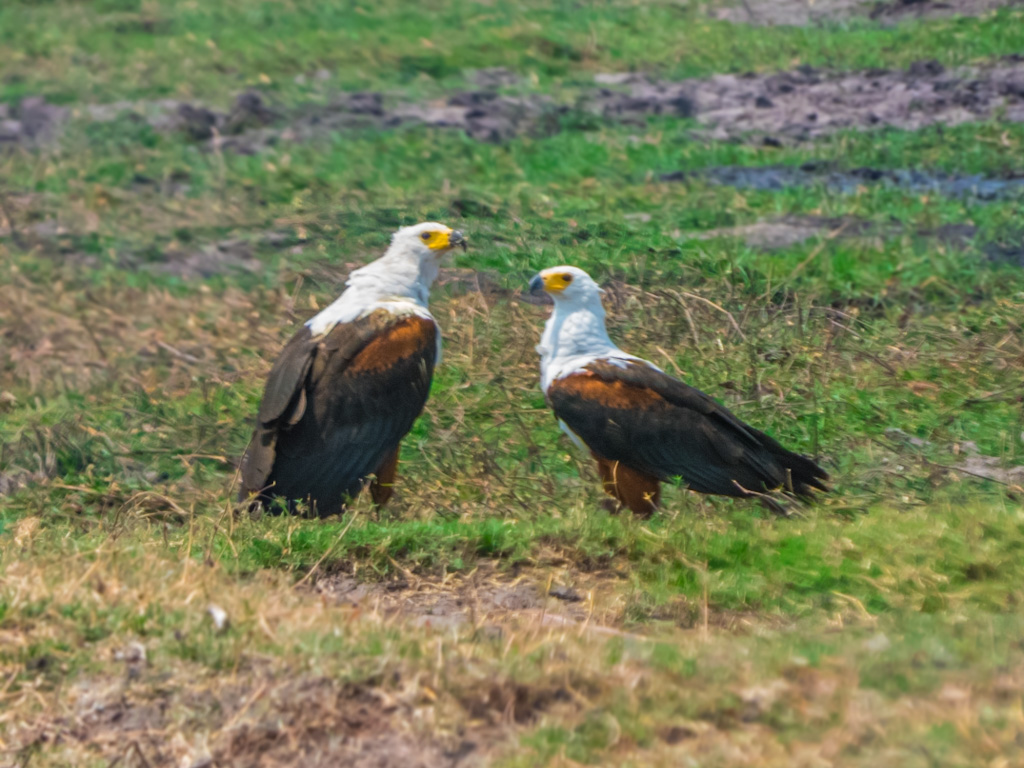
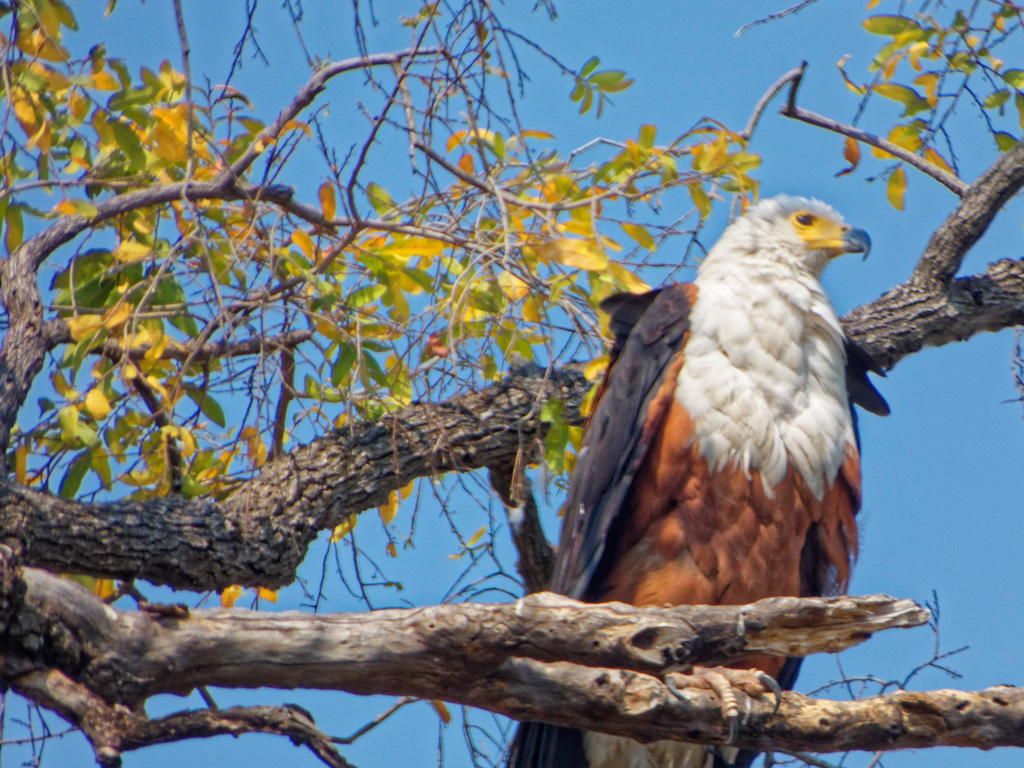
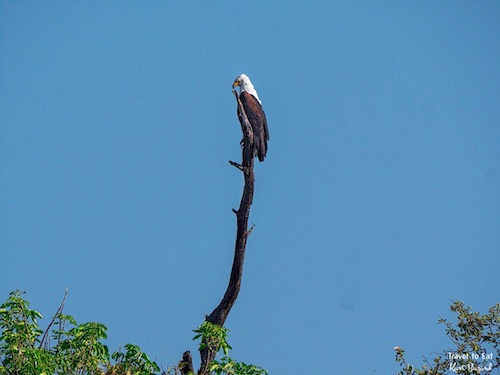
The African fish eagle (Haliaeetus vocifer), or to distinguish it from the true fish eagles (Ichthyophaga), the African sea eagle, is a large species of eagle found throughout sub-Saharan Africa wherever large bodies of open water with an abundant food supply occur. Like the African Fish eagle, the Bald eagle is also a sea eagle, both are in the genus Haliaeetus in the bird of prey family Accipitridae. The African fish eagle is a large bird, and the female, at 7.1–7.9 lb (3.2–3.6 kg) is larger than the male, at 4.4–5.5 lb (2.0–2.5 kg). as seen above. This is typical sexual dimorphism in birds of prey. Males usually have wingspans around 6.6 ft (2 m), while females have wingspans of 7.9 ft (2.4 m). It is the national bird of Namibia, Zimbabwe, Zambia, and South Sudan. This species is still quite common near freshwater lakes, reservoirs, and rivers, although they can sometimes be found near the coast at the mouths of rivers or lagoons. African fish eagles are indigenous to sub-Saharan Africa, ranging over most of continental Africa south of the Sahara Desert. The African fish eagle feeds mainly on fish, which it swoops down upon from a perch in a tree, snatching the prey from the water with its large, clawed talons.
Hooded Vulture
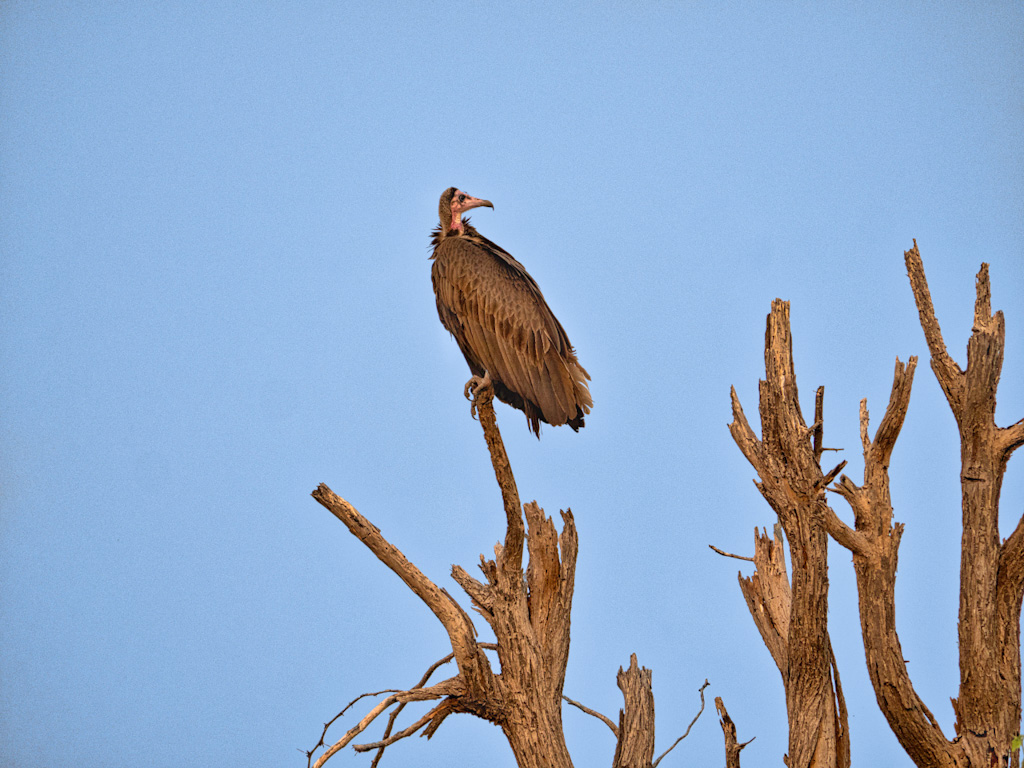
The Hooded Vulture (Necrosyrtes monachus) is an Old World vulture in the order Accipitriformes, which also includes eagles, kites, buzzards and hawks. It is the only member of the genus Necrosyrtes and is native to sub-Saharan Africa. It is a scruffy-looking, small vulture with dark brown plumage, a long thin bill, bare crown, face and fore-neck, and a downy nape and hind-neck. It typically scavenges on carcasses. It breeds in a stick nest in trees (often palms) in much of Africa south of the Sahara, laying one egg. Birds may form loose colonies. The population is mostly resident. This is one of the smaller vultures of the Old World. They are 24–28 in (62–72 cm) long, have a wingspan of 5–5.4 ft (155–165 cm) and a body weight of 3.3–5.7 lb (1.5–2.6 kg). The species has been uplisted from its previous IUCN status of endangered to critically endangered, since the species is going through a very steep decline in population, owing to various factors including poisoning, hunting, habitat loss and degradation of habitat.
White Faced Whistling Duck
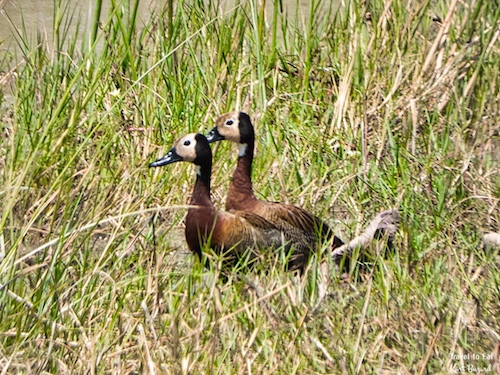
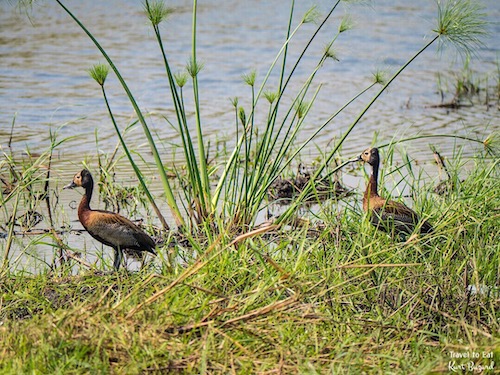
The White-Faced Whistling Duck (Dendrocygna viduata) is a whistling duck that breeds in sub-Saharan Africa and much of South America. As the name implies, these are noisy birds with a clear three-note whistling call. Adults grow to be 17-19 inches (42.5-47.5 cm) in length and weigh one to two pounds (0.45- 0.91 kg), with males being slightly smaller. It is a common resident and nomad at freshwater lakes, lagoons and adjacent grassland, often in large flocks. It feeds on land and in water and occasionally dives for up to 10 seconds. The white-faced whistling duck has a peculiar disjunctive distribution, occurring in Africa and South America. It has been suggested that they may have been transported to new locations worldwide by humans. The habitat is still freshwater lakes or reservoirs, with plentiful vegetation, where this duck feeds on seeds and other plant food.
Spur-Winged Goose
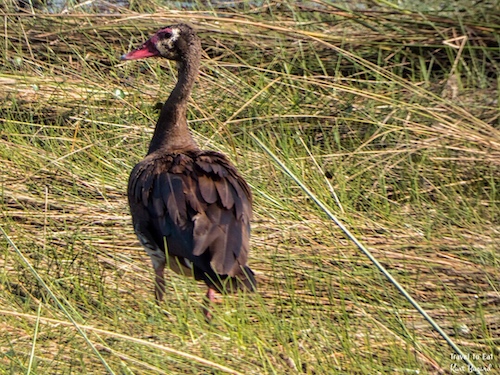
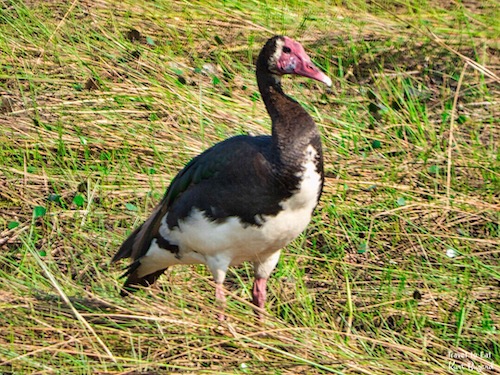
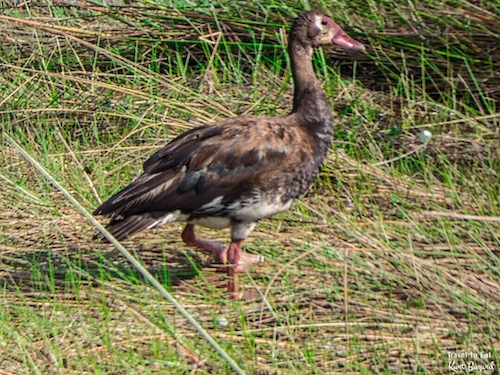
The spur-winged goose (Plectropterus gambensis) is a large bird in the family Anatidae, related to the geese and the shelducks, but distinct from both of these in a number of anatomical features, and therefore treated in its own subfamily, the Plectropterinae. It occurs in wetlands throughout sub-Saharan Africa. They are the largest African waterfowl and are, on average, the world’s largest wild “goose”, although in average weight, their size is at least rivaled by the Cape Barren goose. It is about 2.5-3.3 ft (75–100 cm) long with a weight of 5.5-15.5 lb (2.5–7 kg). The adults are mainly black, with a white face and large white wing patches. Younger specimens such as this are more brown. The long legs are flesh-colored. This bird is often poisonous due to its diet of blister beetles. The poison, cantharidin, is held within the tissue of the fowl resulting in poisoning of those that eat the cooked goose. This is the origin of the English idiom “your goose is cooked.”
Egyptian Goose
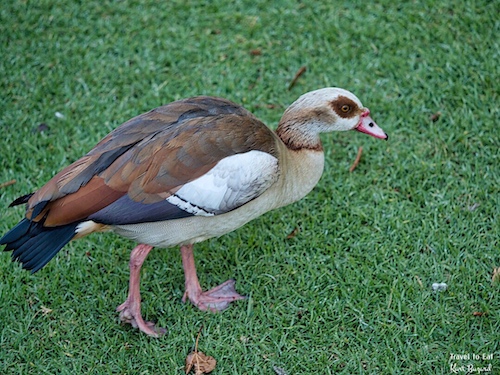
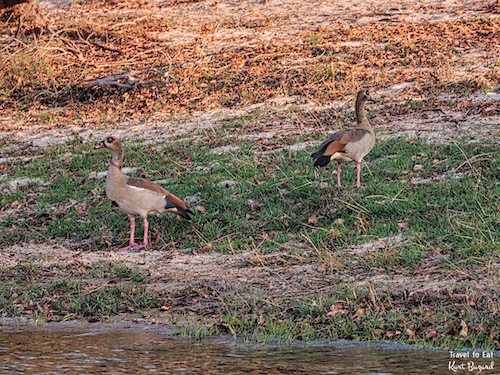
The Egyptian Goose (Alopochen aegyptiaca) is a member of the duck, goose, and swan family Anatidae. It is native to Africa south of the Sahara and the Nile Valley. Egyptian geese were considered sacred by the Ancient Egyptians, and appeared in much of their artwork. They have been raised for food and extensively bred in parts of Africa since they were domesticated by the ancient Egyptians. The Egyptian goose is believed to be most closely related to the shelducks (genus Tadorna) and their relatives, and is placed with them in the subfamily Tadorninae. It swims well, and in flight looks heavy, more like a goose than a duck, hence the English name. It is 25–29 in (63–73 cm) long. This species breeds widely in Africa except in deserts and dense forests, and is locally abundant. They are found mostly in the Nile Valley and south of the Sahara. This is a largely terrestrial species, which will also perch readily on trees and buildings. Egyptian geese typically eat seeds, leaves, grasses, and plant stems. Occasionally, they will eat locusts, worms, or other small animals.
African Sacred Ibis
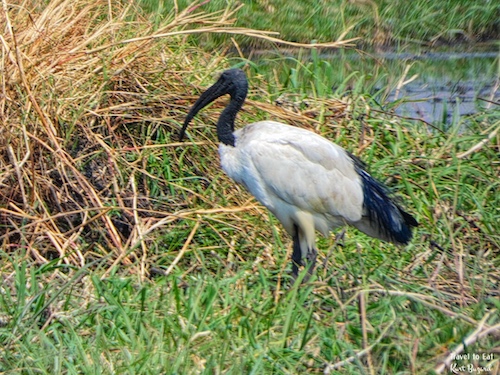
The African sacred ibis (Threskiornis aethiopicus) is a species of ibis. Its sister species is the Australian white ibis. A wading bird of the ibis family, Threskiornithidae, the sacred ibis breeds in Sub-Saharan Africa, southeastern Iraq, and formerly in Egypt, where it was venerated and often mummified as a symbol of the god Thoth. One of the most prominent features of this bird is its long, black, downcurved bill, which has a neck sac positioned underneath its lower surface and is used for probing into soft mud and sand in pursuit of prey. The African sacred ibis occurs in marshy wetlands and mud flats, both inland and on the coast. It will also visit cultivation and rubbish dumps. The diet consists of various fish, frogs, small mammals, reptiles and smaller birds as well as insects and other invertebrates, and carrion. It may also probe into the soil with its long beak for invertebrates such as earthworms.
Glossy Ibis
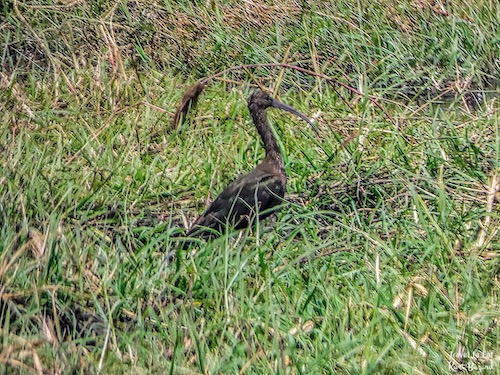
The Glossy Ibis (Plegadis falcinellus) is a wading bird in the ibis family Threskiornithidae. The scientific name derives from Ancient Greek plegados and Latin, falcis, both meaning “sickle” and referring to the distinctive shape of the bill. This is the most widespread ibis species, breeding in scattered sites in warm regions of Europe, Asia, Africa, Australia, and the Atlantic and Caribbean regions of the Americas. Glossy ibises feed in very shallow water and nest in freshwater or brackish wetlands with tall dense stands of emergent vegetation such as reeds, papyrus or rushes) and low trees or bushes. Prey includes adult and larval insects, molluscs, crustaceans and occasionally fish, amphibians, lizards, small snakes and nestling birds.
African Spoonbill
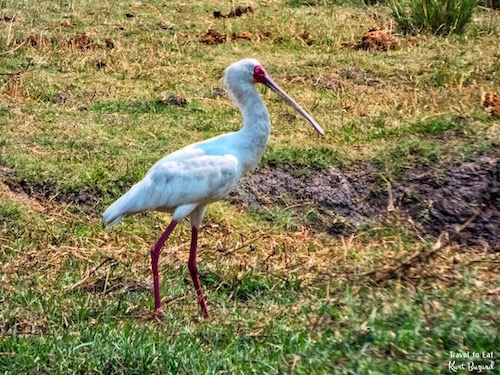
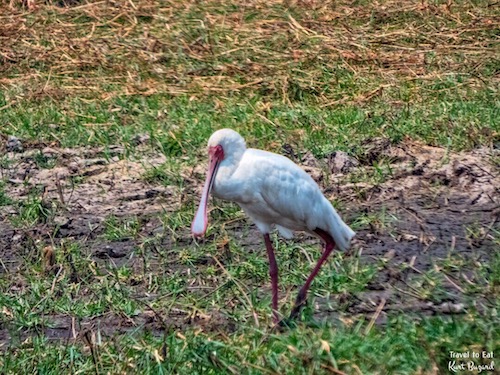
The African Spoonbill (Platalea alba) is a long-legged wading bird of the ibis and spoonbill family Threskiornithidae. The species is widespread across Africa and Madagascar, including Botswana. Average length is 31.5-35.5 in (80-90 cm) with a wingspan of 4-4.5 ft (120-135 cm) and a weight of 2.8-4.6 lbs (1.3-2.1 kg). The “spoon” shape of the African spoonbill’s bill makes it easier it to grab slippery prey in muddy water. The wider tip has more grabbing area than a narrow beak, and is used to feel around for prey using touch rather than sight. African spoonbills are carnivores. Their diet consists of small fish, shellfish, insects, and aquatic invertebrates such as crayfish and water beetles. African spoonbills feed by sticking their wide bills into the water and sweeping them from side to side. When prey is found, they quickly snap their bills to catch it, and then toss it backwards into their mouths with a swift head jerk.
Wattled Crane
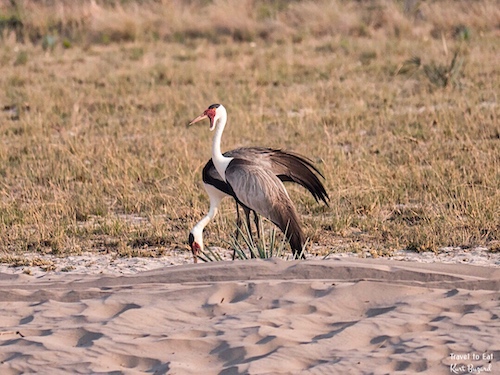
The wattled crane (Grus carunculata) is a large bird found in Africa, south of the Sahara Desert. At a height of up to 175 cm (5.74 ft), it is the largest crane in Africa and is the second tallest species of crane, after the sarus crane. The wingspan is 230–260 cm (7.5–8.5 ft), the length is typically 120 cm (3.9 ft) and weight is 6.4–7.9 kg (14–17 lb) in females, 7.5–9 kg (17–20 lb) in males. The principal food of the wattled crane is mainly aquatic eating the tubers and rhizomes of submerged sedges and water lilies. It is one of the more herbivorous of extant cranes. The other primary portion of the diet consists of aquatic insects. They will supplement the diet with snails, amphibians and snakes when the opportunity arises.
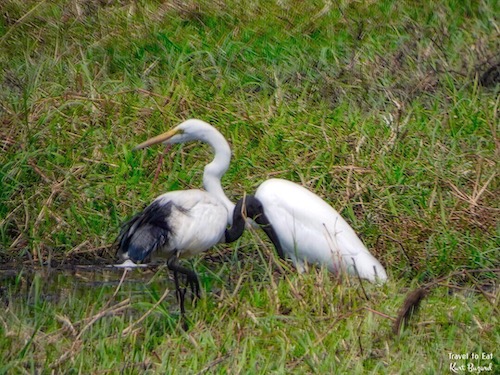
I hope you enjoyed the post, please leave a comment.

